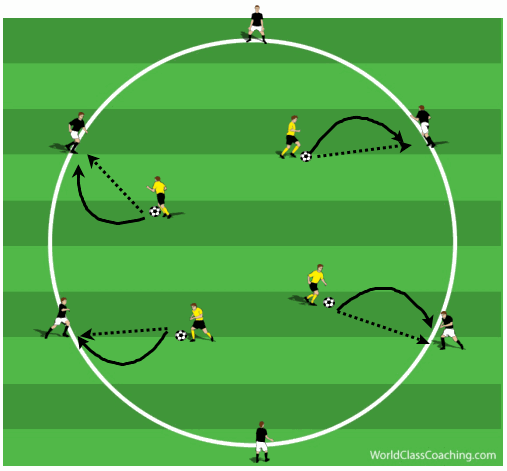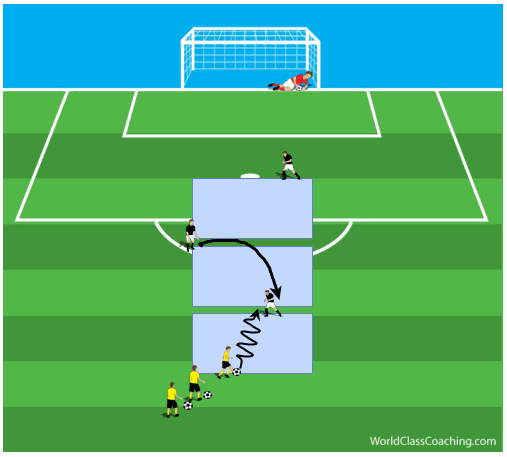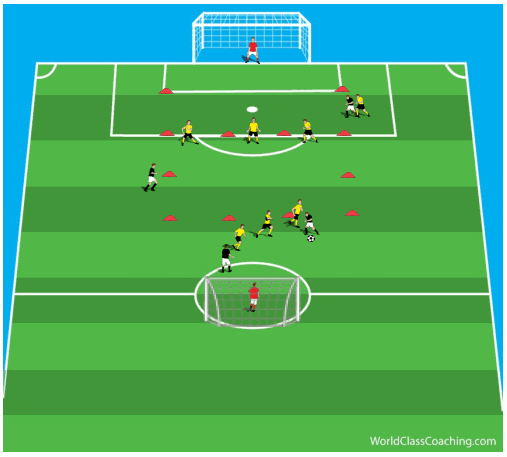By Chris Kouns
USSF A License (USSF Coaching Education Instructor) – NSCAA Premier Diploma (NSCAA Coaching Education Associate Staff Coach) – Head Coach Georgia Gwinnett College Women's Soccer
Activity 1
Around the center circle there will be players on the outside without balls. Inside the center circle there will be a few less players who have the balls at their feet and are dribbling around. When they are ready the players on the inside of the circle will play a ball to a player on the outside. They will follow their ball, closing down the player who is receiving the ball and focusing on proper individual defending shape. The player on the outside will now dribble into the center circle, find someone on the outside to play to and continue the rotation.
ADAPTATIONS
- Player receiving the ball should stop the ball and allow the defender closing them down to ensure they have proper shape and coverage.
- Player receiving the ball can take a positive first touch into the circle forcing the player closing them down to address the distance and speed of their approach
1) It is vital that the defender travels as their ball travels so that they can close the space between them and the attacker prior to the
attacker being in possession.
2) Defenders should travel quickly until the ball is within a yard of the attacker. At that time they should focus on slowing their approach
so the ball is not touched past them. They should also pay attention to their center of gravity and balance so they are in a positive position to deal with a dribbling player.
3) As the defender closes the space be sure to lead with the arm on the same side as their front foot. This arm will act as both a shock absorber against and a guiding tool against players who are dribbling at them
4) When closing down the ball make sure the back foot is staggered so that it is between the ball and the direction of the goal. This foot position will allow the defender to make sure they have not taken too wide a path getting to the attacker.
PROGRESSION
Have two defenders in the circle close it down so that they can work on their tandem defending and positioning.
Activity 2
Set up three 6 x 6 grids (can be up to 8 v 8 grids depending on the ability of your defenders) with the first one at the pk mark and then each successive grid a yard farther up the field. At the back of each grid there should be a line of defenders waiting to enter their defensive grid “zone”. They cannot enter the grid until an attacker has entered their zone. The attackers will enter at the top of the three grids and will try maintain possession while getting through to the next grid to take on the next defender. When an attacker makes it into the third grid they can shoot from within the grid or try to dribble the keeper, if they come out of the third grid still in possession they have a free 1 v 1 with the GK.
ROTATIONS AND RESTRICTIONS
Defenders must not get into the grid too early, so, they should time their entry, and path of entry, to meet the attacker and close them into a manageable space.
All defenders will rotate with each attacker. So, the player defending the last zone (nearest the pk spot) may not face the attacker if they lose possession in the first grid. But, once that ball is lost then the defender from the last grid will move up to join the line for the second grid. The player defending the second grid would move up to join the line of defenders in the first grid and the player who defended the first grid will join the last line of defenders closes to the pk.
1) The first defender to face an attacker should try to minimize the amount of space the attacker has to work with by closing the player with the ball with the idea of winning the ball, but, also
understanding that success is simply not allowing that player to go vertically up the field and get
in behind them.
2) Although they are not working in a defending pair (specifically) the defenders in each successive grid should begin to position themselves as to approach the attacker based on what space they “might” attack take after beating the defender in the grid before them.
3) The player who is defending should keep in mind that their top priority is to keep that player from getting behind them. So, they should use their arms and body to deny the attacker the vertical space. Individual defending must be viewed in the light of an individual battle that cannot be lost! When you can not afford to lose you use everything at your disposal to try to win. That includes your body not just your feet!
PROGRESSION
You can increase the number of attacking players to 2 v 1 and then allow the defenders in the subsequent zones to move into their defending areas based on the space where the pair may try to come through as well as where the ball might be played.
Activity 3
This activity will require two full size goals facing each other at the end line and the midline. The space in between will be divided into three vertical zones and the width of each zone being that of the 6 yd box. In the zone nearest midfield there will be three (3) defenders vs two (2) attackers. The next zone will see one attacking player on the side of the grid waiting to join in (if the two make it past the first three defenders). There will also be three defenders on the end line for the grid who will go three (3) v three (3) with those attackers as they enter. Then, outside the final zone there will be one (1) attacking player and one (1) defending player. Once the 3 v 3 in the middle zone commences the last attacking player can enter the final grid whenever they want, but, the defending player with them cannot enter until the attacker does.
RESTRICTIONS AND SCORING
In the first grid the two attacking players can use the GK to help them keep possession and try to break into the middle zone. If the three defenders win the ball they can try to score on the GK immediately. Once the pair breaks into the middle zone the first three defenders cannot follow. So, it is only the three defenders on the grid end line who have to do the job. These three defender can follow the attackers into the final grid so you have the potential for a 4 v 4 in the last grid with the attackers trying to score. Should the four defenders win the ball they will look to play the three defenders in the first grid who will then attack against two new attacking players.
ADAPTATION – You can play the activity so that the four defenders do not play the first three after winning the ball, but, I believe it makes more sense in terms of training our players to attack when they win a ball rather than just give it back to the team up top.
1) First three defending players must use both visual and verbal cues in order to work together and force the attacking players into “pressure pockets” where they will be more likely to win the ball. Cues include body shape of player closest to the ball, technical ability of the player on the ball and the proximity of support for the player on the ball.
2) Player on the ball defensively should take responsibility for providing their helpers clear communication (body) in terms of
where they might be able to win the ball and stop vertical progression. Players behind the first player should offer them verbal confirmation of what they are seeing “Keep bringing him left, I am here”
3) In the middle & final grid there must be an urgency to the defending as the attackers are within striking distance. Raise your level of intensity to match the threat level.
By Chris Kouns: USSF A License (USSF Coaching Education Instructor) – NSCAA Premier Diploma (NSCAA Coaching Education Associate Staff Coach) – Head Coach Georgia Gwinnet College Women’s Soccer (GA)





